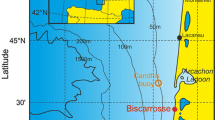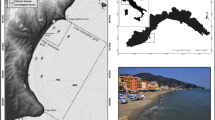Abstract
The rip currents induced by waves off arc-shaped coastlines are seriously harmful to humans, but understanding of their characteristics is lacking. In this study, the FUNWAVE model was used to calculate the wave-induced currents in the Haller experiment and the ideal arc-shaped coast similar to Sanya Dadonghai, Hainan Province, China. The results showed that the FUNWAVE model has considerable ability to simulate the rip currents, and it was used to further simulate rip currents off arc-shaped coastlines to investigate their characteristics. The rip currents were found to be stronger as the curvature of arc-shaped coastline increased. Coastal beach slope exerts a significant influence on rip currents; in particular, an overly steep or overly mild slope is not conducive to creating rip currents. Furthermore, the rip currents were found to become weaker as the size of arc-shaped coast decreased. When the height and period of waves increase, the strength of rip currents also increases, and, in some cases, wave heights of 0.4 m may produce dangerous rip currents.
Similar content being viewed by others
References
Bae J S, Yoon S B, Choi J. 2013. Boussinesq modelling of a rip current at Heaundae Beach in South Korea. Journal of Coastal Research, 65: 654–659
Bowen A J. 1969. Rip currents: 1. Theoretical investigations. Journal of Geophysical Research, 74(23): 5467–5478
Brown J, MacMahan J H, Reniers A, et al. 2009. Surf zone diffusivity on a Rip-Channeled Beach. Journal of Geophysical Research, 114(C11): doi: 10.1029/2008JC005158
Castelle B, Coco G. 2012. The morphodynamics of rip channels on embayed beaches. Continental Shelf Research, 43: 10–23
Castelle B, Michallet H, Marieu V, et al. 2010. Laboratory experiment on rip current circulations over a moveable bed: drifter measurements. Journal of Geophysical Research, 115(C12): doi: 10.1029/2010JC006343
Chen Qin, Dalrymple R A, Kirby J T, et al. 1999. Boussinesq modeling of a rip current system. Journal of Geophysical Research, 104(C9): 20617–20637
Choi J, Shin C H, Yoon S B. 2013. Numerical study on sea state parameters affecting rip current at Haeundae Beach: wave period, height, direction and tidal elevation. Journal of Korea Water Resources Association, 46(2): 205–218
Dalrymple R A, Macmahan J H, Reniers A J H M, et al. 2011. Rip currents. Annual Review of Fluid Mechanics, 43(1): 551–581
Dean R G, Oh T M. 1994. Three dimensional morphology in a narrow wave tank: measurements and theory. In: 24th International Conference on Coastal Engineering. Kobe, Japan: ASCE, 1918
Drønen N, Karunarathna H, Fredsøe J, et al. 2002. An experimental study of rip channel flow. Coastal Engineering, 45(3-4): 223–238
Fang Kezhao, Zou Zhili, Liu Zhongbo. 2011. Numerical simulation of rip current generated on a barred beach. Chinese Journal of Hydrodynamics (in Chinese), 26(4): 479–486
Giger M, Dracos T, Jirka G H. 1991. Entrainment and mixing in plane turbulent jets in shallow water. Journal of Hydraulic Research, 29(5): 615–642
Ha T, Jun K, Yoo J, et al. 2014. Numerical study of rip current generation mechanism at Haeundae Beach, Korea. Journal of Coastal Research, S72: 179–183
Haas K A, Svendsen I A. 2002. Laboratory measurements of the vertical structure of rip currents. Journal of Geophysical Research, 107(C5): 15–1–15–19
Haller M C, Dalrymple R A, Svendsen I A. 2002. Experimental study of nearshore dynamics on a barred beach with rip channels. Journal of Geophysical Research, 107(C6): 14–1–14–21
Hass K A, Svendsen I A, Haller M C, et al. 2003. Quasi-three-dimensional modeling of rip current systems. Journal of Geophysical Research, 108(C7): 3217
Hsu J R C, Silvester R, Xia Yimin. 1989. Applications of headland control. Journal of Waterway, Port, Coastal, and Ocean Engineering, 115(3): 299–310
Huntley D A, Hendry M D, Haines J, et al. 1988. Waves and rip currents on a Caribbean Pocket beach, Jamaica. Journal of Coastal Research, 4(1): 69–79
Jin Hong, Zou Zhili, Qiu Dahong, et al. 2006. The effects of wave-induced currents on the transport of pollutant outside and inside surf zone. Haiyang Xuebao (in Chinese), 28(6): 144–150
Kennedy A B, Thomas D. 2004. Drifter measurements in a laboratory rip current. Journal of Geophysical Research, 109(C8): C08005
Lascody R L. 1998. East central florida rip current program. National Weather Digest, 22(2): 25–30
Li Zhiqiang, Li Weiquan, Chen Zishen, et al. 2014. Influencing factors and classifications of arc-shaped coasts in South China. Acta Geographica Sinica (in Chinese), 69(5): 595–606
Li Zhiqiang. 2016. Rip current hazards in South China headland beaches. Ocean & Coastal Management, 121: 23–32
Li Zhiqiang, Zhu Yamin. 2015. Beach safety evaluation based on rip current morphodynamic: a case study of Dadonghai of Sanya, China. Tropical Geography (in Chinese), 35(1): 96–102
MacMahan J H, Thornton E B, Reniers A J H M. 2006. Rip current review. Coastal Engineering, 53(2-3): 191–208
Shi Fengyan, Kirby J T, Harris J C, et al. 2012. A high-order adaptive time-stepping TVD solver for Boussinesq modeling of breaking waves and coastal inundation. Ocean Modelling, 43-44: 36–51
Shin C H, Noh K, Yoon S B, et al. 2014. Understanding of rip current generation mechanism at Haeundae Beach of Korea: honeycomb waves. Journal of Coastal Research, 72: 11–15
Short A D. 2007. Australian rip systems-friend or foe? Journal of Coastal Research, S50: 7–11
Wang Yan, Zou Zhili. 2014. Progress and prospect of rip currents. Haiyang Xuebao (in Chinese), 36(5): 170–176
Wei G, Kirby J T, Sinha A. 1999. Generation of waves in Boussinesq models using a source function method. Coastal Engineering, 36: 271–299
Author information
Authors and Affiliations
Corresponding author
Additional information
Foundation item: The National Natural Science Foundation under contract Nos 41206163, 41076048 and 41376012; the Operation Expenses for Universities' Basic Scientific Research of Central Authorities under contract Nos 2011B05714 and 2014B06514.
Rights and permissions
About this article
Cite this article
Wang, H., Zhu, S., Li, X. et al. Numerical simulations of rip currents off arc-shaped coastlines. Acta Oceanol. Sin. 37, 21–30 (2018). https://doi.org/10.1007/s13131-018-1197-1
Received:
Accepted:
Published:
Issue Date:
DOI: https://doi.org/10.1007/s13131-018-1197-1




